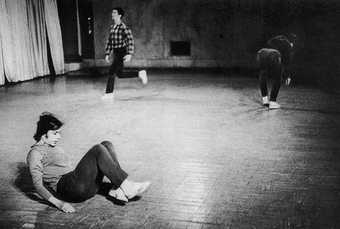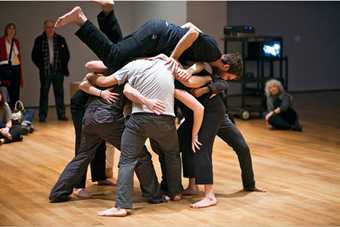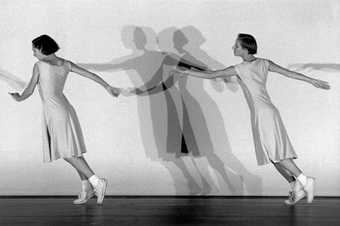
Performance of Yvonne Rainer's The Mind is a Muscle: Trio A, Judson Memorial Church, Greenwich Village, New York, 1966
Courtesy Yvonne Rainer Studio © Yvonne Rainer
In the US, the birth of contemporary dance can be traced to the West Coast. In the first half of the twentieth century, three influential female dancers and choreographers connected to the area had a huge impact on dance.
Isadora Duncan was born in San Francisco in the late 1870s, though her career flourished worldwide and she lived much of her life in Paris. In 1903 she gave a lecture in Berlin entitled ‘The Dance of the Future’, which set out her philosophy of dance:
The dancer of the future will be one whose body and soul have grown so harmoniously together that the natural language of the soul will have become the movement of the body. … She will dance not in the form of a nymph, nor fairy, nor coquette but in the form of a woman in its greatest and purest expression.
Popular ballet and burlesque or music hall dance performances of this time were stylised spectacle and narrative, but Duncan was proposing and pioneering an expressive form of dance, which she traced back to ancient Greece where she felt dance had been ‘a high religious art’.
Martha Graham grew up in California in the early years of the twentieth century. She trained and taught at the Los Angeles Denishawn School of Dancing and Related Arts, set up by Ruth St. Denis and Ted Shawn in in 1915. Graham’s father was a doctor specialising in ‘nervous disorders’, who subscribed to the idea that the body displayed its inner feelings. This often is taken as setting another precedent for Graham, who founded her own dance company in 1926.
I wanted to begin not with characters or ideas, but with movements …I wanted significant movement. I did not want it to be beautiful or fluid. I wanted it to be fraught with inner meaning, with excitement and surge.
The key component of Graham’s dance was the connection with gravity (rather than trying to defy gravity as ballet did). They used the floor for rolling and crouching movements, kept their feet flat on the ground (rather than en pointe), and contracted and released their bodies from the solar plexus (as Isadora Duncan had also suggested). The movements seem rather familiar to us now, but at the time they were shocking and exciting, seeming free and wild and maybe even dangerous in their liberty. Graham collaborated with musicians and artists including Aaron Copland and Isamu Noguchi.
Anna Halprin rejected the styles and techniques of Graham and other modern dance pioneers of the thirties and forties, as she felt they were too closely linked to their originators; for Halprin, all Graham’s dancers danced like Graham. Moving to San Francisco after the second world war, Halprin’s husband Lawrence built her an outdoor deck to dance on, which in his words ‘removed the proscenium arch, presented new and different spatial relationships and enveloped the performers with the natural sounds and elements of nature’.
Halprin was extremely influential in the 1950s and 60s. Interested in dance as part of everyday life, her experimental movement workshops on the dance deck attracted dancers and non-dancers, including Yvonne Rainer, Robert Morris and Trisha Brown. Participants in her workshops collaborated with each other and with the environment, each affecting the movements of the others. Her works in the 1960s were important ground-breakers, both in content and performance techniques. Parades & Changes from 1965 included dancers using everyday movements like walking and embracing, and broke out of the stage and into the audience. It was banned in New York for nudity.
Halprin was a contemporary of Merce Cunningham, who had trained with Martha Graham in New York. Like Halprin, Cunningham also rejected the narrative elements and stylisations of preceding choreography and embraced chance and ordinary movements in his pieces. For Cunningham, movement was no longer tied to music and often dancers did not hear the music or see the set till the performance. A number of dancers attended both Halprin’s workshops and Cunningham’s classes, drawing on these experiences to make their own choreography.
The Judson Dance Theater’s first concert in 1962 presented 23 works by members of Robert Dunn’s composition class at the Cunningham Studio. Dunn had studied at John Cage’s classes at the New School, and applied many of Cage’s ideas in his own teaching. Those attending Dunn’s classes included (now recognised pioneers of dance and performance) Yvonne Rainer, Simone Forti, Lucinda Childs, Meredith Monk and Trisha Brown.
Students brought work to the classes and shared it with each other. The Judson Dance Theater, performing between 1962 and 1964, was an extension of that process. Rainer described the first concert at the Judson Memorial Church in New York (which already showed concerts, plays, poetry and some happenings) as ‘a three-hour marathon for a capacity audience of about 300, sitting from beginning to end in the un-air conditioned 90-degree heat’. Audience members at the first concert arrived while a film (edited using an elaborate system to randomise the film strips) was already playing, apparently to confound expectations of a concert and of dance. The film melded into the first piece of dance, with the performers appearing towards the end of the moving image. The group used found sound and found or ordinary movements, as well as experimental music and film. Rainer presented Ordinary Dance, which in its use of repetitive everyday movements with a spoken text illustrated many of the concerns of the group. Chance (like the toss of a coin) was also used as a way to choreograph and to direct. These dancers and artists were questioning and breaking the boundaries of dance, producing a radical interpretation of what dance was and could be.
In 1965 Yvonne Rainer produced her No Manifesto for dance:
No to spectacle.
No to virtuosity.
No to transformations and magic and make-believe.
No to the glamour and transcendency of the star image.
No to the heroic.
No to the anti-heroic.
No to trash imagery.
No to involvement of performer or spectator.
No to style.
No to camp.
No to seduction of spectator by the wiles of the performer.
No to eccentricity.
No to moving or being moved.
Stripping dance back to its barest bones, she created minimal works, focused on movement and body rather than drama and emotion. In Continuous Project – Altered Daily, Rainer sought to expose the process of choreography and rehearsal, showing the repetition and task-based nature of the work. Brown, Rainer and others came together out of Rainer’s CP-AD to form Grand Union, a group focused on improvisation. Wearing casual clothes, incorporating conversation and ordinary everyday movements (what Simone Forti called pedestrian movements) their collaborative process was displayed. Having all worked together intensively over the last decade, they pushed each other’s boundaries in their funny and conversational performances. Rainer also often used film in her works in what has come to be called expanded cinema, conceiving live performance and film together. Rainer made the transition from choreographer to filmmaker in the mid-1970s.

Performance 2: re-enactment of Simone Forti’s Huddle 1961 at the Museum of Modern Art, New York in 2009
Courtesy Museum of Modern Art, New York
© 2009 Yi-Chun Wu
Trisha Brown broke dance out of the theatre and into the street, working with the idea that dance is gravity. She produced works like Man Walking down the Side of a Building 1970, where one of the dancers (harnessed and roped) sauntered down the outside of a building in Wooster Street in New York’s SoHo, or used all of a given space – not just the floor – as in 1971’s Walking on the Walls. Later works such as Simone Forti’s Striding Crawling 1977, which uses holography to show the artist performing the actions from the title, incorporate sculpture, image technology and movement in new ways.
Across the Atlantic during the same period, European expressive, non-narrative and free dance was taking a similar path, though the outcomes were slightly different.
Ballet might have been rejected by Duncan, but Diaghilev’s avant-garde Ballets Russes managed to shock and excite European audiences in the early 1910s with erotic choreography and folk-dance-inspired movements. Vaslav Nijinsky’s performance of Prélude à l’après-midi d’un Faune, danced to Debussy’s score of the same name, caused a scandal at its first performance in Paris in 1912, as it ended with the faun erotically caressing and suggestively penetrating a scarf stolen from a nymph. His choreography for Stravinsky’s Rite of Spring with its rhythmic music and startling and ‘primitive’ movement, not to mention its pagan theme of ritual sacrifice was even more incendiary, causing a riot amongst the 1913 Parisian audience.
Pioneering Expressive dance in Europe were Rudolf Laban and Mary Widman. Like Graham, they proposed expressive movements, grounded in the earth and tapping into universal rhythms, while remaining theatrical and narratively focused. Laban in particular, with his belief that dance was for everyone, was particularly influential, first in Germany and then in the UK.
In Germany, Oskar Schlemmer’s Stage Workshop of the late 1920s at the Bauhaus (founded in 1919) created a series of avant-garde ballets and dance performances. The Bauhaus was concerned with uniting all the arts, design and technology to create the gesamstkunstwerk, the total work of art, and Schlemmer’s ballets incorporated extraordinary costumes, geometric props and abstract sets into their simple choreographies. When the Bauhaus was closed by the Nazis in 1932, many of the artists fled to America, where they began to influence artists such as those associated with the Black Mountain College.
Later influential European dance drew on these theatrical traditions far more than their counterparts in the US. Pina Bausch was appointed director of the Wuppertal Ballet, which she renamed Tanztheater Wuppertal, in 1973. Born in 1940, she had trained in ballet in Germany as a teenager and then in New York at the Juillard school in the late 1950s, absorbing influences from both continents. The word Tanztheater (or dance theatre) came from Laban, and signalled a move away from ballet as a series of routines to freedom and expression. Bausch’s work came from her classical training and could be funny or ferocious. She used sets and costumes that, while simple, were often potent images: pools of water, forest floors or soaring films of jungle treetops. Unlike Rainer’s rejection of drama, Bausch amplified it and brought it to the repetitive movements or phrases the athletic dancers executed, aiming to bring an emotional force to her often dreamlike works. Bausch’s 1975 Rite of Spring might not have caused a riot, but the raw set and physical choreography delivered an emotional punch of its own.
William Forsythe also came to prominence in the 1970s. Born and trained in America, he became resident choreographer for the Stuttgart Ballet in 1976. In 1988, his Impressing the Czar, a highly theatrical spectacle pushed the boundaries of contemporary dance, by creating a ballet that was a comment on the history (and failings) of ballet itself, as well as wider Western culture. Comic, camp and startling, it incorporated spoken word, non-dancers, elaborate sets and costumes and experimental music as well as classical scores. Forsythe’s choreographic work fuses Western classical ballet, contemporary dance and dance from around the world as well as using technology in his performances. Forsythe is widely credited with forcing ballet into the twenty-first century and making it seem an innovative art form in its own right (worlds away from the traditional idea of the ballerina in tutu and point shoes). Forsythe also creates films and interactive insallations including film, gesture and apparatus in visual art galleries, calling these Choreographic Objects.

Anne Teresa De Keersmaeker
Fase: Four movements to the Music of Steve Reich 1982
Photo: Herman Sorgeloos
Belgian dancer and choreographer Anne Teresa de Keersmaeker founded the company Rosas in 1983. The previous year, she had presented Fase, a piece choreographed to the music of Steve Reich, which had proved a sensation. A dance of repeating patterns, Fase also used the ordinary movement so critical to modern and contemporary dance – familiar gestures and steps. De Keersmaeker’s work, like Bausch’s, is both expressive and non-narrative, and often incorporates fast-paced choreography, dancers leaping and tumbling with almost violent energy. She also works with film and text and the voices of the dancers and a range of classical and popular music, blurring the edges of contemporary dance and experimental theatre. Though it may often seem that contemporary dance is difficult and avant-garde, the recent scandal around claims of plaigiarism from De Keersmaker’s choreography in Beyonce’s Countdown video shows just how much mainstream culture borrows and embraces the movements that had seemed so shocking only years before.
